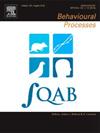一种高度群居的啮齿动物——浩亭田鼠(Microtus hartingi)幼鼠隔离引起的超声波叫声的个体发生
IF 1.3
4区 生物学
Q4 BEHAVIORAL SCIENCES
引用次数: 0
摘要
我们研究了一种高度社会化的Arvicolinae啮齿类动物Harting 's田鼠(Microtus hartingi)幼鼠超声隔离诱导呼叫(USVs)的个体发生。我们每隔两天记录11窝1 ~ 12日龄的55只幼崽的usv,并测量每只幼崽的体重和线性体型变量。产生usv的幼崽数量从1-2日龄的100% %下降到11-12日龄的11. %。呼唤率随日龄变化,在3 ~ 4 d达到最大值。1 ~ 2 ~ 7 ~ 8日龄时为121.8 ~ 94.2 usv /min, 9 ~ 10日龄时为36.4 usv /min, 11 ~ 12日龄时为1.5 usv /min。总体而言,随着年龄的增长,幼犬usv的轮廓形状变得越来越简单。除起始频率和最大基频外,幼犬年龄类别显著影响所有声学变量,其值随年龄没有显着变化。排除呼叫率后,体重与USV声学变量呈负相关。很高比例的无人潜航器包含非线性现象。讨论了浩亭田鼠幼鼠USV个体发育与其他田鼠的异同,总结了浩亭田鼠幼鼠USV个体发育的特点,使其成为生物医学研究的一个方便模型。本文章由计算机程序翻译,如有差异,请以英文原文为准。
Ontogeny of pup isolation-induced ultrasonic calls in a highly social rodent, the Harting’s vole (Microtus hartingi)
We examined the ontogeny of pup ultrasonic isolation-induced calls (USVs) in a highly social Arvicolinae rodent species, the Harting’s vole (Microtus hartingi). We recorded, with two-days intervals, the USVs of 55 individual pups from 11 litters from 1 to 12 days of age and measured body mass and the linear body size variables of each subject. The number of pups producing USVs decreased from 100 % at 1–2 days of age to 11.5 % at 11–12 days of age. Call rate changed with age, with maximum at 3–4 d of age. It ranged from 121.8 to 94.2 USVs/min between 1–2 and 7–8 days of age, decreased to 36.4 USVs/min at 9–10 days of age and to 1.5 USVs/min at 11–12 days of age. Overall, pup USVs were becoming simpler in their contour shapes with increase of age. Pup age class significantly affected all acoustic variables for the exclusion of the start and maximum fundamental frequencies, which values did not display significant changes with age. Body mass negatively correlated with USV acoustic variables, for the exclusion of call rate. A high percent of USVs contained nonlinear phenomena. We discuss the differences and similarities of pup Harting’s vole USV ontogeny with other vole species and summarize the traits which make pup USVs of the Harting’ vole a convenient model for biomedical research.
求助全文
通过发布文献求助,成功后即可免费获取论文全文。
去求助
来源期刊

Behavioural Processes
生物-动物学
CiteScore
2.70
自引率
7.70%
发文量
144
审稿时长
4-8 weeks
期刊介绍:
Behavioural Processes is dedicated to the publication of high-quality original research on animal behaviour from any theoretical perspective. It welcomes contributions that consider animal behaviour from behavioural analytic, cognitive, ethological, ecological and evolutionary points of view. This list is not intended to be exhaustive, and papers that integrate theory and methodology across disciplines are particularly welcome.
 求助内容:
求助内容: 应助结果提醒方式:
应助结果提醒方式:


